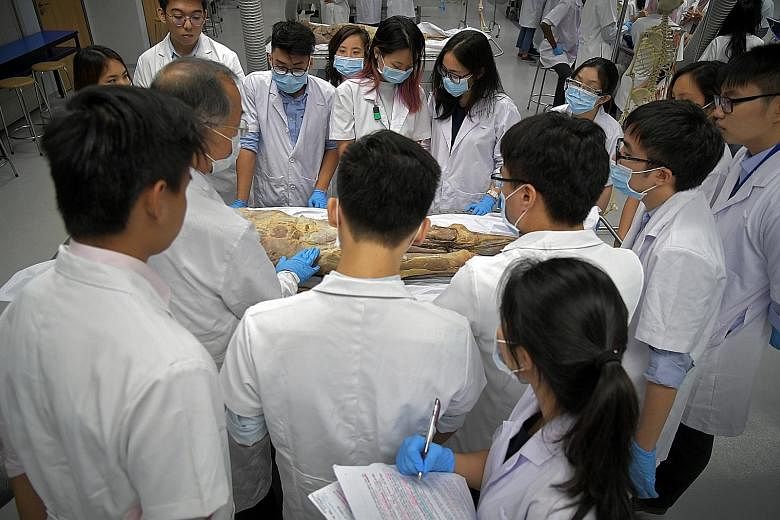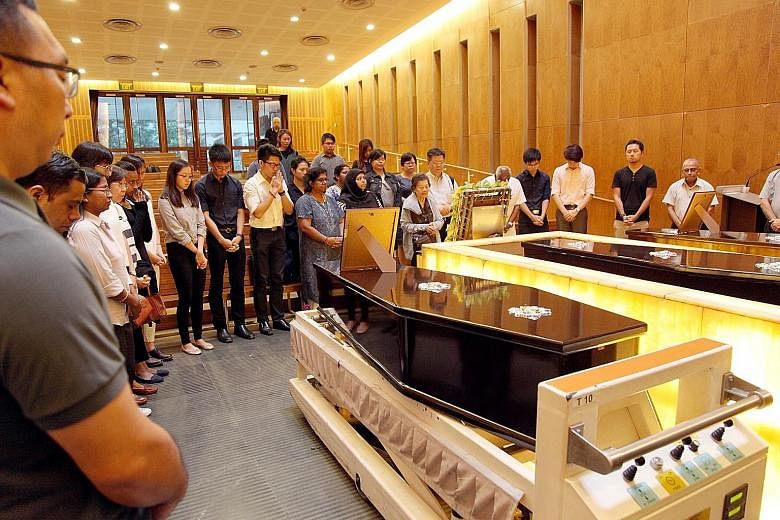During the June school holidays, 20-year-old Joshua Lee spent several hours daily in the company of cadavers.
It is something the medical student is thankful for. The number of donated human bodies here for science has increased over the years, allowing for the return of dissection classes that had been put on ice for over a decade.
"Every morning, I would have a few moments of silence before I start dissecting," said Mr Lee, a National University of Singapore (NUS) student. Next to the cadaver is a photograph of the person when he or she was alive, along with the name, age and cause of death.
"The details make us meticulous. We want to make sure that every incision is made carefully."
In 2003, the university's Yong Loo Lin School of Medicine, one of three medical schools here, stopped its dissection classes when faced with a shortage of human cadavers. Such classes allow students to get a feel of what it is like to handle a body during surgery.
The elective was reintroduced last year and 60 students took it. This year, some 120 students did.
It was made possible because of a surge in the number of donated bodies to the school. This year so far, its anatomy department has received about 20 donated bodies, compared with six in 2012. They came via the Silent Mentors Programme started in 2012 to promote body donation for science.
-
20
Number of donated bodies the anatomy department of the Yong Loo Lin School of Medicine has received so far this year, up from six in 2012.
Associate Professor Ng Yee Kong, coordinator of the programme, was surprised at the increase, saying: "People are more open than what we had initially thought."
The donors come from a variety of backgrounds and include a construction worker and a doctor. There are more males than females.
Noting that Singapore is still largely conservative, Dr Ng attributed the higher numbers to greater public awareness and the assurance given to families that their loved ones' remains would be handled sensitively.
"Using human bodies is still the best because that's as real as it gets," he said.
Besides donation, cadavers are also obtained when bodies are unclaimed - the school's traditional source.
Schools use alternative ways to teach human anatomy
However, this quantity fluctuates. For a long time, the figure to NUS has been below 10, said Dr Ng. "The number of unclaimed bodies is inconsistent, so we cannot rely on that totally.
"Regularly, we would need at least 10 cadavers every year, if we are to retain the conventional way of teaching, because we have to replace them due to wear and tear."
Donated cadavers are used for teaching for up to three years. The bodies are then cremated and the remains returned to the families.
Dr Ng said even more bodies would be needed if the school offers more programmes, such as workshops for surgeons, in future.
With cadavers still set to be in short supply, medical schools here are looking at other ways of helping their students learn about human anatomy and dissection.
At Duke-NUS Medical School, radiological imaging and bones and plastinised models are also used.
At the Nanyang Technological University's Lee Kong Chian School of Medicine, plastinated bodies - cadavers preserved with plastic - are used, along with an interactive table that displays 3D images of full-body anatomy and medical imaging.
Plastinated bodies, which can last for 10 to 15 years, are non-toxic and have no smell, but are rigid. Fine structures such as nerves may break easily after repeated handling.
Assistant Professor Reddy Mogali, the school's head of anatomy, said these specimens are pre-dissected to demonstrate the anatomical features in great detail.
At NUS, first-year medical students attend anatomy prosection classes, where they work with cadavers already dissected by experts.
Second-year medical student Soong Tse Kiat, 20, who took the lessons last year, said that initially, it was an uncomfortable experience. "The first thing that hits you is the smell," he said, referring to the pungent odour of formaldehyde, which is used in preserving the cadavers.
On their first day in the anatomy hall, the students are faced with body bags on rows of tables. They then take a pledge to treat the cadavers with dignity.
"We were asked to open the bags, place one hand on the cadavers and take a pledge," said Mr Soong. "When you touch the cadaver, it feels cold. And you realise you are touching a dead person."
He added that the feelings of unease fade away after weeks of learning. "With cadavers, we get to see our textbooks come to life. They are like our teachers."
Sometimes, family members of the donors would leave flowers outside the anatomy hall. Every year, students hold appreciation ceremonies where they share reflections, read poems and sing songs to remember these "silent mentors".
"The family members have to wait for three years before they can see their loved ones again for their final send-off," said Dr Ng. "We tell students it is not their right, but a privilege given to them by this very special group of people."



